9 Surprising Things Home Inspectors Look for in Boston
As life events go, buying a home can be as stressful as it gets. And for those looking to buy a house or condo in the white hot Boston housing market, the stakes are especially high. Carefully-considered reason can be thrown out the window as multiple would-be buyers outbid one another for the more desirable properties, sending the final sale price soaring tens of thousands of dollars above asking price.
But amidst the stress and euphoria of the house hunt is the often sobering reality of the home inspection. Boston, with its oscillating (but lovable) climate and long history, presents some unique challenges that can make or break a real estate deal or worse, send unexpected wads of cash up to proverbial or actual chimney for unaware buyers.
To find out what home buyers should be looking for in Boston, we talked to two home inspection experts who have seen their fair share the issues that affect local housing stock: Mike Atwell of J. May Home Inspections and Ray Jackson of Jackson Home Inspection.
Here are 9 things that Atwell and Jackson recommend Boston homebuyers look for when deciding to sign on the bottom line, or not.
1. Rotting pilings
Like much of the city, the Back Bay and parts of the South End were built on landfill—their grand old brownstones and other structures supported by a system of wooden pilings. These pilings must stay submerged in water otherwise they will begin to rot, a problem that became apparent during the 2016 drought. Before you snap up that gorgeous condo in one of these areas, your home inspector will want to check the sub-basement to ensure there is no structural damage from potentially rotted pilings.
2. Outdated wiring systems
Many of Boston’s older homes have outdated, faulty wiring systems that can lead to power outages or worse, electrical fires. One common old system that home inspectors check for is knob and tube—cloth covered, ungrounded wiring that is considered outdated and inadequate to cover today’s heavier electrical needs.
3. Leaky windows
Inspectors regularly see older houses with outdated and inefficient windows that can become costly to the homeowner in the long run due to replacement and heat loss. The problem? Old wooden trim that warps, cracks, and buckles over the decades.
Basement windows in particular are often neglected until the trim begins to rot and moisture starts seeping into the basement, causing a host of other problems like mold.
4. Mold, and mold-like substances
Sometimes black, sometimes invisible to the naked eye, mold can be very costly to remove and can lead to health issues—some of them very serious. Mold can sneak into a house from a number of places, the most common being in the attic and the basement where moisture enters the house through ice dams and other leaks. Be aware that your home inspector can alert you to “mold-like substances,” but it will take specialized testing to tell you if the suspect substance is something that will make or break your real estate deal.
5. Structural conditions
Even the most solidly built New England home is susceptible to the ravages of time. Inspectors regularly see older Boston homes with a variety of structural and foundation issues, such as major cracks, dry rot, moisture damage to pilings, unevenness in the slab or perimeter foundation wall, and other issues.
6. Old wooden siding
Old houses with wooden siding may appear charming, but looks can be deceiving! Wooden siding is high maintenance and needs to be painted every seven years, an expensive and tedious process that few homeowners look forward to. Older wooden siding gets cracked and warped in the tough New England climate, which can lead to penetrations in the building envelope.
7. Plumbing problems
One danger of an old or substandard plumbing system is the possibility of a pipe failure and subsequent water damage in the structure. Another danger is that a pipe has already been quietly leaking, causing water damage within the floors or walls. All pipe systems are not created equal. Pipes made from PEX, an increasingly common plastic material, can last 40 or 50 years, whereas steel pipes can start failing after 20 years. Before purchasing an any home, ask the seller how old the plumbing system is and what material was used.
8. Faulty installation
It’s not just older homes that have their issues—new homes and condo constructions have their fair share of problems, according to our experts. One common problem that they see in the newer constructions is building materials not installed according the manufacturer recommendations. So while the property may look perfect now, expensive issues could pop up when you least expect it.
9. Hidden headaches
Sometimes a home inspection reveals a completely unexpected problem with the property that would not have been discovered without the expert knowledge of the home inspector. Abandoned oil tanks forgotten for decades under the front lawn that the new homeowner will be on the hook for removing? Faulty and crumbing underground parking areas that are costing condo associations millions to fix? Our experts have seen those issues and many more.
Reduce your chances of a less-than-stellar home inspection by choosing a home built with materials and components designed to last. If you currently own your dream home, keep it home inspector friendly and secure with industry-standard materials and craftsmanship than can and will withstand the highs and lows of New England weather, such as reinforced concrete and fiber cement siding, and if you can swing it, copper roofing.
Learn more about how Fiber Cement siding from James Hardie has been protecting homes and families in Boston and around the world at JamesHardie.com.
This is a paid partnership between James Hardie and Boston Magazine




